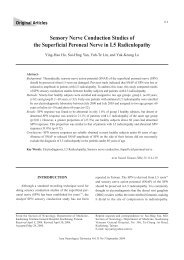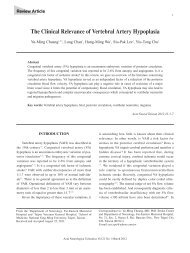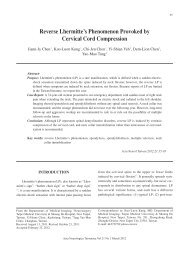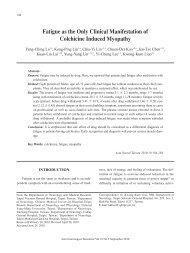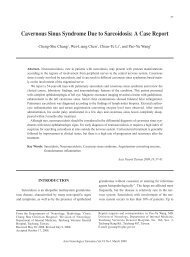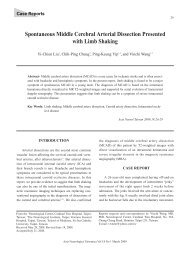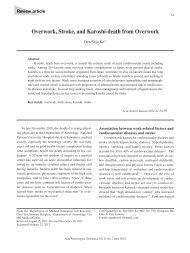Ramsay Hunt Syndrome with Hemiparesis and ... - Vol.22 No.1
Ramsay Hunt Syndrome with Hemiparesis and ... - Vol.22 No.1
Ramsay Hunt Syndrome with Hemiparesis and ... - Vol.22 No.1
You also want an ePaper? Increase the reach of your titles
YUMPU automatically turns print PDFs into web optimized ePapers that Google loves.
276<br />
<strong>Ramsay</strong> <strong>Hunt</strong> <strong>Syndrome</strong> <strong>with</strong> <strong>Hemiparesis</strong> <strong>and</strong> Hemihypoesthesia:<br />
Report of 2 Cases<br />
Chen-Wen Fang <strong>and</strong> Chou-Ching K. Lin<br />
Abstract- <strong>Ramsay</strong> <strong>Hunt</strong> syndrome (RHS) complicated <strong>with</strong> encephalitis is rare, <strong>and</strong> the appearance of<br />
hemi-motosensory deficit in RHS is even rarer. We reported two such cases. Both patients had a peripheral<br />
type facial palsy, facial numbness <strong>and</strong> zoster in the ipsilateral ear canal. The consciousness was clear <strong>and</strong><br />
cognitive function was normal. The functional deficits of extremities were ipsilateral to the facial palsy in<br />
one case, but contralateral in the other. Magnetic resonance imaging of the brain in both cases showed no<br />
abnormality. The manifestations were compared <strong>with</strong> two more cases from the literature.<br />
Key Words: <strong>Ramsay</strong> <strong>Hunt</strong> syndrome, Encephalitis, <strong>Hemiparesis</strong>, Hemi-hypoesthesia<br />
Acta Neurol Taiwan 2009;18:276-280<br />
INTRODUCTION<br />
Varicellar zoster virus (VZV), a double-str<strong>and</strong> DNA<br />
virus, belongs to the family of Herpesviridae <strong>and</strong> the<br />
subfamily of α-herpesvirinae. It is transmitted by respiratory<br />
droplets of the host <strong>and</strong> causes chickenpox <strong>and</strong><br />
shingles (zoster) in human. In year 1907, <strong>Hunt</strong> reported<br />
the clinical syndrome of herpes zoster oticus, consisting<br />
of facial paralysis of lower-motor-neuron type, otalgia<br />
<strong>and</strong> auricular vesicles (1) . Although he was not the first<br />
one to report this syndrome, it was later named as<br />
<strong>Ramsay</strong> <strong>Hunt</strong> syndrome (RHS). The syndrome is<br />
believed to be caused by reactivation of VZV in the<br />
geniculate ganglion <strong>and</strong> produces skin lesions in corresponding<br />
muco-cutaneous areas, including the ear <strong>and</strong><br />
the ipsilateral side of the tongue. Various vestibulecochlear<br />
manifestations may occur if cranial nerve VIII<br />
is affected because of a byst<strong>and</strong>er effect (2,3) . In most<br />
cases, RHS usually consists of symptoms related to<br />
injury to the ganglions <strong>and</strong> peripheral nerves. RHS<br />
accounted for 4.5% (116/2570) of patients <strong>with</strong> peripheral<br />
facial nerve palsies (4) . On the other h<strong>and</strong>, there were<br />
different neurological symptoms accompanying Bell’s<br />
palsy, including facial tingling (46%), blurred vision<br />
(29%), ipsilateral limb paresthesias (17%), ipsilateral<br />
limb weakness (14%) <strong>and</strong> feelings of clumsiness<br />
(13%) (5) .<br />
According to the study of Kin et al. (6) , there were<br />
only 8 cases in the English <strong>and</strong> Japanese literature that<br />
documented the coexistence of RHS <strong>and</strong> VZV<br />
encephalitis (7 from previous reports <strong>and</strong> 1 of their<br />
own). They attributed the small number of cases to the<br />
From the Department of Neurology, National Cheng Kung<br />
University Hospital, Tainan, Taiwan.<br />
Received March 6, 2009. Revised April 13, 2009.<br />
Accepted June 3, 2009.<br />
Reprint requests <strong>and</strong> correspondence to: Dr. Chou-Ching K.<br />
Lin, MD. Department of Neurology, National Cheng Kung<br />
University Hospital, No. 138, Sheng Li Road, Tainan 704,<br />
Taiwan.<br />
E-mail: cxl45@mail.ncku.edu.tw<br />
Acta Neurologica Taiwanica Vol 18 No 4 December 2009
277<br />
lack of clearly documented evidence in the previous<br />
reports <strong>and</strong> the rarity of both RHS <strong>and</strong> VZV encephalitis.<br />
Only two cases in their review exhibited weakness of<br />
extremities. We report here another two cases of RHS<br />
<strong>with</strong> motosensory impairment in the ipsilateral or contralateral<br />
limbs.<br />
CASE REPORT<br />
Case 1<br />
The patient was a 47-year-old male Taiwanese. He<br />
denied past history of chickenpox in his childhood,<br />
major systemic disease or operations. He did not take<br />
any regular medications. He did administrative service in<br />
the government <strong>and</strong> have not traveled to foreign countries<br />
recently.<br />
Initially (day 1), he suffered from flu-like symptoms,<br />
including sneezing, mild tinnitus in the right ear <strong>and</strong><br />
episodes of involuntary twitching in the right face. He<br />
also noticed vague pain in the right post-auricular area.<br />
Because these symptoms were subtle <strong>and</strong> had no effect<br />
on his daily activities, he did not take it seriously.<br />
However, it became more difficult to control his right<br />
face when he smiled or ate on day 3. He thus hurried to<br />
our hospital for help. Physical examination revealed<br />
right peripheral-type facial palsy <strong>and</strong> post-auricular pain.<br />
There is no fever, vesicles or limbs weakness. Oral prednisolone<br />
40 mg per day was prescribed for 4 days under<br />
the impression of Bell’s palsy. Neurophysiological tests,<br />
including nerve conduction velocity study of the facial<br />
nerves <strong>and</strong> blink reflexes were arranged.<br />
Although feeling more at ease, the patient experienced<br />
additional symptoms in the next 4 days, including<br />
impaired hearing of the right ear, mild fever <strong>and</strong><br />
unsteady gait <strong>with</strong> deviation to the left side. Also, the<br />
post-auricular pain exacerbated <strong>and</strong> spread to the right<br />
ear, cheek <strong>and</strong> orbital areas. He could not work anymore<br />
<strong>and</strong> had to come to our emergency room on day 8 when<br />
he found himself feverish (up to 38°C). On examination,<br />
his consciousness was clear <strong>and</strong> he was orientated to<br />
time, place <strong>and</strong> people. In addition to the symptoms<br />
mentioned above, tinny vesicles <strong>and</strong> tenderness in <strong>and</strong><br />
near the right ear canal were noticed. Hearing acuity of<br />
the right ear was decreased <strong>and</strong> mild weakness of the left<br />
upper <strong>and</strong> lower extremities (5- on the upper <strong>and</strong> lower<br />
extremities) was detected. Deep tendon reflexes in all<br />
four limbs were symmetric <strong>and</strong> normal. The left side of<br />
his body, including limbs <strong>and</strong> trunk, were less sensitive<br />
to pain by pinprick test (7/10). His left h<strong>and</strong> showed dysmetria<br />
at finger-nose-finger test. Barany’s past pointing<br />
test revealed lateral deviation of the left h<strong>and</strong>.<br />
He was hospitalized from day 10 to day 20. During<br />
admission, his basic biochemistry data were <strong>with</strong>in normal<br />
limits. Electroencephalography was normal. Results<br />
of nerve conduction velocity study were compatible <strong>with</strong><br />
a clinical diagnosis of peripheral-type facial palsy on the<br />
right side. Brainstem auditory evoked potential was normal.<br />
Brain magnetic resonance imaging (MRI) <strong>with</strong> <strong>and</strong><br />
<strong>with</strong>out gadolinium on day 9 revealed no abnormality.<br />
Lumbar puncture was performed smoothly on day<br />
11. The open/close pressure was 185/130 mmH 2<br />
O. The<br />
appearance of cerebrospinal fluid (CSF) was clear.<br />
However, the WBC count was elevated to 225/mm 3 while<br />
the RBC count were 0/mm 3 . The leukocytes consisted of<br />
lymphocytes (96%) <strong>and</strong> macrophage (4%). Other CSF<br />
data included decreased glucose level (39 mg/dL, 128<br />
mg/dL in simultaneous serum sample), elevated total<br />
protein (88 mg/dL) <strong>and</strong> lactate (2.2 mmol/L). However,<br />
viral isolation from CSF <strong>and</strong> cotton swab of post-auricular<br />
skin both reported negative results. VZV antigen was<br />
absent <strong>and</strong> polymerase chain reaction revealed no nucleic<br />
acid of herpes simplex virus in the CSF.<br />
His symptoms improved after treatment <strong>with</strong> intravenous<br />
acyclovior (10 mg/kg q8h) for 10 days. The<br />
hypoesthesia to pinprick on the right side of face, the left<br />
side of body, <strong>and</strong> in the left limbs improved from 7/10 to<br />
9~10/10. Dysmetria of the left limbs recovered completely.<br />
There were still residual deficits, including<br />
weakness of the left extremities, right post-auricular<br />
pain, <strong>and</strong> tinnitus on the day of discharge, when the<br />
facial palsy was in Brackmann stage VI.<br />
Case 2<br />
The patient was a 44-year-old healthy woman. The<br />
first symptom was tinnitus of the right ear (day 1).<br />
Swelling sensation <strong>and</strong> dull pain of the right ear <strong>and</strong> reddening<br />
of the right eye appeared 10 days later (day 11).<br />
Acta Neurologica Taiwanica Vol 18 No 4 December 2009
278<br />
In another 2 weeks (day 25), decreased taste sensation,<br />
right facial hypoesthesia <strong>and</strong> right facial palsy developed<br />
<strong>with</strong> tearing from the right eye, easy choking, numbness<br />
<strong>and</strong> weakness of the right extremities. She came to our<br />
emergency room on the next day (day 26). Tiny crust <strong>and</strong><br />
scarring in the acoustic meatus <strong>and</strong> swelling of the right<br />
auricle were noticed. The right peripheral-type facial<br />
palsy was in Brackmann stage IV. Under the tentative<br />
diagnosis of <strong>Ramsay</strong> <strong>Hunt</strong> syndrome, oral valaciclovir<br />
(1000 mg tid) <strong>and</strong> prednisolone (60 mg qd) were prescribed<br />
for 3 days <strong>and</strong> she was discharged. Because the<br />
symptoms persisted, she was referred to the outpatient<br />
clinic of the department of neurology on day 33. In addition<br />
to the right peripheral-type facial palsy, there were<br />
dysphagia <strong>and</strong> motor-sensory deficits in the right limbs.<br />
Under the impression of <strong>Ramsay</strong> <strong>Hunt</strong> syndrome complicated<br />
<strong>with</strong> encephalitis, she was hospitalized on the<br />
same day, roughly one month after the onset of the first<br />
symptom.<br />
Complete neurological examination revealed right<br />
peripheral-type facial palsy, right hemiparesis (grade 4<br />
muscle power in both upper <strong>and</strong> lower limbs) <strong>and</strong> hypesthesia<br />
to vibration <strong>and</strong> pinprick (3/10 on the right side of<br />
the face, 5/10 in the right upper limb <strong>and</strong> trunk, <strong>and</strong> 7/10<br />
in the right lower limb). There was no dysmetria<br />
revealed by the finger-nose-finger or heel-knee-shin<br />
tests. The taste sensations to bitter, salty <strong>and</strong> sweet stimulants<br />
were intact. Her basic biochemistry data were<br />
<strong>with</strong>in normal limits. Lumbar puncture was performed<br />
smoothly on day 34. The open/close pressure was<br />
150/100 mmH 2<br />
O. The appearance of CSF was clear, but<br />
there were mildly elevated WBC (12/mm 3 , <strong>with</strong> 10 lymphocytes<br />
<strong>and</strong> 2 polymorphonuclear cells) <strong>and</strong> RBC<br />
counts (41/mm 3 ). The remaining CSF was sent for other<br />
studies, including sugar (77 mg/dL, 133 mg/dL in simultaneous<br />
serum sample), total protein (37 mg/dL) <strong>and</strong> lactate<br />
(1.6 mmol/L). Viral isolation of CSF <strong>and</strong> cotton<br />
swab of post-auricular skin both revealed negative result.<br />
VZV IgG <strong>and</strong> antigen were absent in the CSF. The<br />
evoked potential studies, including visual, sensory,<br />
motor <strong>and</strong> brainstem-auditory evoked potentials, were all<br />
normal. Facial nerve conduction velocity study <strong>and</strong> blink<br />
reflexes on day 35 confirmed the diagnosis of peripheral-type<br />
facial palsy on the right side. Mini-mental state<br />
examination showed a score of 28/30 <strong>and</strong> cognitive ability<br />
screening instrument 93/100, both being <strong>with</strong>in normal<br />
limits. MRI of the brain <strong>with</strong> <strong>and</strong> <strong>with</strong>out gadolinium<br />
was performed on day 34 <strong>and</strong> revealed no abnormality.<br />
Tc-99m single photon emission computed tomography<br />
showed no deficit of cerebral blood perfusion, either.<br />
Intravenous acyclovir (500 mg q8h) was given for 7 days<br />
from day 33. After treatment, the facial palsy improved.<br />
The muscle power of the right upper limb increased to 5-<br />
<strong>and</strong> the right lower limb to 4+. The pain sensation by<br />
pinprick improved to 10/10 on the face <strong>and</strong> 8/10 in the<br />
body <strong>and</strong> limbs.<br />
DISCUSSION<br />
RHS is a clinical syndrome that may include different<br />
combinations of symptoms. The core definition of<br />
RHS requires (1) herpes zoster auricularis or herpes<br />
zoster in any of the sensory zones corresponding to the<br />
trigeminal branches in the face, <strong>and</strong> (2) ipsilateral facial<br />
palsy. The definition of VZV encephalitis is confusing.<br />
According to the report of Kin et al. (6) , it requires impairment<br />
of consciousness <strong>and</strong> focal signs of the central nervous<br />
system. In addition, the symptoms should be associated<br />
<strong>with</strong> VZV infection, which had to be confirmed<br />
by clinical (herpes zoster) or laboratory findings (positive<br />
VZV DNA in CSF, anti-VZV IgM in CSF or a fourfold<br />
or greater increase in the anti-IgG titer in CSF<br />
obtained at an interval of at least 2 weeks). In other<br />
words, involvement of any structure or system in the<br />
central nervous system could be regarded as encephalitis.<br />
Kim et al. (7) reported a case of RHS complicated by a<br />
brainstem lesion (rhombencephalitis). The presentation,<br />
however, was regarded as the manifestation of nucleus<br />
invasion in cranial polyneuropathy in other reports (8,9) .<br />
Booss <strong>and</strong> Esiri (10) classified the neurological complications<br />
of herpes zoster infection into syndromes <strong>and</strong> circumstances.<br />
The syndromes included stroke, aseptic<br />
meningitis, cranial neuropathy/brain stem encephalitis,<br />
cerebellitis, encephalitis <strong>and</strong> myelitis. In this classification,<br />
encephalitis was more restricted to the impairment<br />
of consciousness <strong>and</strong> cognition.<br />
Acta Neurologica Taiwanica Vol 18 No 4 December 2009
279<br />
The coexistence of RHS <strong>and</strong> VZV encephalitis is<br />
rare <strong>and</strong> Kin et al. (6) found only 8 cases, including one<br />
case of their own, in English <strong>and</strong> Japanese literature (6) .<br />
When the data were examined more closely, we found<br />
that these patients could be divided into two groups<br />
according to the presence of disturbed consciousness<br />
(encephalitis) <strong>and</strong> pyramidal sign (stroke-like), similar to<br />
the classification of Booss <strong>and</strong> Esiri (10) . Since our cases<br />
showed hemiparesis <strong>with</strong>out disturbance of consciousness,<br />
we compare our cases <strong>with</strong> those previously reported<br />
cases in the stroke-like group (Table). The motor <strong>and</strong><br />
sensory deficits of the limbs were on the same side in all<br />
the cases, <strong>and</strong> were on the same side as the deficits of<br />
the face in 3 cases. Dysmetria was described in one case.<br />
Image studies were performed in 3 cases <strong>with</strong> lesions<br />
reported in one case. Brain MRI performed in case 4<br />
showed a lesion in the middle of the pons, more to the<br />
contralateral side of the midline (11) . Delayed ipsilateral<br />
cerebral infarction leading to contralateral hemiparesis<br />
Table. Comparison of the cases in the present study <strong>and</strong><br />
from review of the literatures<br />
Case no.* 1 2 3 4<br />
Disturbed consciousness – – +<br />
Facial palsy R R R L<br />
Facial numbness R R R L<br />
<strong>Hemiparesis</strong> L R R L<br />
Hemihypoesthsia L R R L<br />
Dysmetria L – ND –<br />
Image modality CT, MRI CT, MRI ND MRI<br />
Image finding – – ND +<br />
CSF<br />
WBC (/mm 3 ) 225 12 184 0<br />
Protein (mg/dL) 88 37 ND Normal<br />
Viral detection – † – ND – <br />
R: right; L: left; ND: not described.<br />
* Cases 1 <strong>and</strong> 2 are cases 1 <strong>and</strong> 2 described in this report,<br />
case 3 is from Taukayama (20)<br />
<strong>and</strong> case 4 is from Mizock et<br />
al. (11) . † CSF VZV antigen, viral culture, <strong>and</strong> serum VZV IgG<br />
were all negative. CSF VZV IgG <strong>and</strong> antigen, <strong>and</strong> viral culture<br />
were all negative. CSF VZV PCR was negative <strong>and</strong><br />
serum VZV IgG was positive.<br />
was a well documented complication of herpes zoster<br />
ophthlmicus (12-15) . It was suggested that the virus may<br />
travel along the ophthalmic branch of the trigeminal<br />
nerve to reach the vessel wall of internal carotid artery in<br />
the cavernous sinus. Affected vessels showed thrombosis<br />
<strong>and</strong> inflammation. However, the lesion in the pons of<br />
case 3 was more likely ascribable to a direct extension<br />
from the infected cranial nerve nucleus. Cases of cerebral<br />
infarction outside the facial area following zoster<br />
were also reported (16,17) . These cases indicated that virus<br />
could be disseminated to the vessels via blood or CSF.<br />
Image studies of the brain in both of our cases showed<br />
no lesion. The pathogenesis of ipsilateral weakness <strong>and</strong><br />
sensory deficit in case 2 was especially intriguing. There<br />
are two possibilities. The virus may spread from the<br />
facial nerve to the basilar artery <strong>and</strong> then to the structures<br />
in the brain stem, causing brain stem encephalitis<br />
or brain stem infarction. On the other h<strong>and</strong>, there may be<br />
generalized vasculopathy of different severity, resulting<br />
in focal encephalitis or stroke. In fact, for the neurological<br />
manifestations of VZV infection, the border between<br />
encephalitis <strong>and</strong> vasculopathy is getting blurred.<br />
Gilden (18) suggested to discard the term VZV encephalitis<br />
completely <strong>and</strong> use only VZV vasculopathy, because<br />
vasculopathy is the main pathogenetic mechanism for the<br />
neurological syndromes of VZV infection. In other<br />
words, small vessel vasculopathy may be responsible for<br />
symptoms of diffuse encephalitis, whereas large vessel<br />
vasculopathy would have manifestations of focal<br />
deficits.<br />
In a retrospective study of 265 patients <strong>with</strong> peripheral-type<br />
facial palsy (19) , abnormal CSF findings could<br />
occur in both Bell’s palsy (12.6%) <strong>and</strong> RHS (64.7%). In<br />
this regard, the most frequent abnormalities of CSF were<br />
pleocytosis. However, the incidence (41.3% in the cases<br />
of Bell’s palsy <strong>with</strong> abnormal CSF findings <strong>and</strong> 100% in<br />
RHS) <strong>and</strong> cell count (on average 23 WBC/ mm 3 in Bell’s<br />
palsy <strong>and</strong> 84 in RHS) were significantly different. The<br />
CSF of case 1 taken on day 11, showing prominent<br />
leukocytosis (225/mm 3 ) <strong>with</strong> lymphocyte predominance,<br />
indicating an aseptic infection or inflammation of the<br />
central nervous system <strong>and</strong> thus in favor of the diagnosis<br />
of RHS. Leukocytosis in the second case was mild<br />
Acta Neurologica Taiwanica Vol 18 No 4 December 2009
280<br />
(12/mm 3 ). It could be ascribed to the relatively “late”<br />
lumbar puncture which was performed 34 days after the<br />
onset of first symptom, <strong>and</strong>/or to the partial treatment by<br />
oral valaciclovior.<br />
According to the recommendations for the management<br />
of herpes zoster (20) , RHS was a VZV infection of<br />
non-truncal involvement <strong>and</strong> should be treated <strong>with</strong> systemic<br />
anti-viral agents. Moreover, the recommendation<br />
also emphasized that severe neurological complications<br />
of VZV, including meningitis, encephalitis <strong>and</strong> myelitis,<br />
should be treated by not only by systemically but specifically<br />
by intravenous acyclovir. In these 2 cases, if we had<br />
missed their weakness, sensory deficits <strong>and</strong> other focal<br />
signs, we would have given them oral but not intravenous<br />
acyclovir for RHS. This could be an under-treatment <strong>and</strong><br />
result in increased risk of further complications. The<br />
cases presented in this report underscore the importance<br />
of a complete neurological examination of face <strong>and</strong><br />
limbs in patients <strong>with</strong> a chief complaint of facial weakness<br />
or a tentative diagnosis of peripheral-type facial<br />
palsy.<br />
REFERENCES<br />
1. <strong>Hunt</strong> JR. On herpetic inflammations of the geniculate ganglion.<br />
A new syndrome <strong>and</strong> its complications. Nerv Ment<br />
Dis 1907;34:73-96.<br />
2. Grose C, Bonthius D, Afifi AK. Chickenpox <strong>and</strong> the geniculate<br />
ganglion: facial nerve palsy, <strong>Ramsay</strong> <strong>Hunt</strong> syndrome<br />
<strong>and</strong> acyclovir treatment. Pediatr Infect Dis J 2002;21:615-<br />
7.<br />
3. Sweeney CJ, Gilden DH. <strong>Ramsay</strong> <strong>Hunt</strong> syndrome. J Neurol<br />
Neurosurg Psychiatry 2001;71:149-54.<br />
4. Peitersen E. Bell’s palsy: the spontaneous course of 2,500<br />
peripheral facial nerve palsies of different etiologies. Acta<br />
Otolaryngol Suppl 2002:4-30.<br />
5. Morris AM, Deeks SL, Hill MD, et al. Annualized incidence<br />
<strong>and</strong> spectrum of illness from an outbreak investigation<br />
of Bell’s palsy. Neuroepidemiology 2002;21:255-61.<br />
6. Kin T, Hirano M, Tonomura Y, et al. Coexistence of<br />
<strong>Ramsay</strong> <strong>Hunt</strong> syndrome <strong>and</strong> varicella-zoster virus<br />
encephalitis. Infection 2006;34:352-4.<br />
7. Kim JH, Chung PW, Oh S, et al. <strong>Ramsay</strong> <strong>Hunt</strong> syndrome<br />
complicated by a brainstem lesion. J Clin Virol 2007;39:<br />
322-5.<br />
8. De S, Pfleiderer AG. An extreme <strong>and</strong> unusual variant of<br />
<strong>Ramsay</strong> <strong>Hunt</strong> syndrome. J Laryngol Otol 1999;113:670-1.<br />
9. Nogueira RG, Seeley WW. <strong>Ramsay</strong> <strong>Hunt</strong> syndrome associated<br />
<strong>with</strong> spinal trigeminal nucleus <strong>and</strong> tract involvement<br />
on MRI. Neurology 2003;61:1306-7.<br />
10. Booss J, M. EM. Varicella-zoster virus: The paradox of<br />
immune mediation <strong>and</strong> immunocompromise. In: Viral<br />
Encephalitis in Human. Washington, D.C.: ASM Press,<br />
2003:127-39.<br />
11. Mizock BA, Bartt R, Agbemazdo B. Herpes zoster oticus<br />
<strong>with</strong> pontine lesion: segmental brain-stem encephalitis.<br />
Clin Infect Dis 2000;30:229-30.<br />
12. Bourdette DN, Rosenberg NL, Yatsu FM. Herpes zoster<br />
ophthalmicus <strong>and</strong> delayed ipsilateral cerebral infarction.<br />
Neurology 1983;33:1428-32.<br />
13. Freedman MS, Macdonald RD. Herpes zoster ophthalmicus<br />
<strong>with</strong> delayed cerebral infarction <strong>and</strong> meningoencephalitis.<br />
Can J Neurol Sci 1987;14:312-4.<br />
14. Hilt DC, Buchholz D, Krumholz A, et al. Herpes zoster<br />
ophthalmicus <strong>and</strong> delayed contralateral hemiparesis caused<br />
by cerebral angiitis: diagnosis <strong>and</strong> management approaches.<br />
Ann Neurol 1983;14:543-53.<br />
15. Reshef E, Greenberg SB, Jankovic J. Herpes zoster ophthalmicus<br />
followed by contralateral hemiparesis: report of<br />
two cases <strong>and</strong> review of literature. J Neurol Neurosurg<br />
Psychiatry 1985;48:122-7.<br />
16. Kumar A, Mollison L. Cerebral infarction following thoracic<br />
herpes zoster. Australas J Dermatol 1993;34:113-4.<br />
17. Ross MH, Abend WK, Schwartz RB, et al. A case of C2<br />
herpes zoster <strong>with</strong> delayed bilateral pontine infarction.<br />
Neurology 1991;41:1685-6.<br />
18. Gilden DH. Varicella zoster virus vasculopathy <strong>and</strong> disseminated<br />
encephalomyelitis. J Neurol Sci 2002;195:99-101.<br />
19. Kohler A, Chofflon M, Sztajzel R, et al. Cerebrospinal<br />
fluid in acute peripheral facial palsy. J Neurol 1999;246:<br />
165-9.<br />
20. Dworkin RH, Johnson RW, Breuer J, et al. Recommendations<br />
for the management of herpes zoster. Clin Infect Dis<br />
2007;44:S1-26.<br />
Acta Neurologica Taiwanica Vol 18 No 4 December 2009



